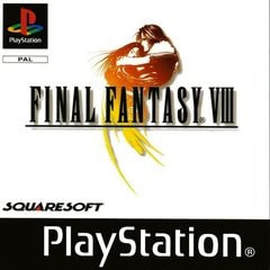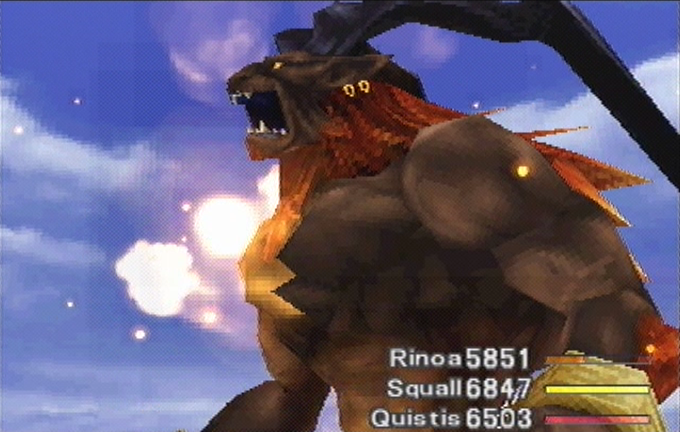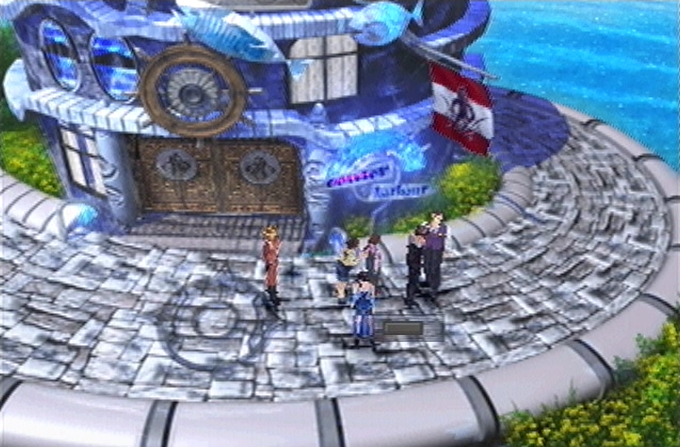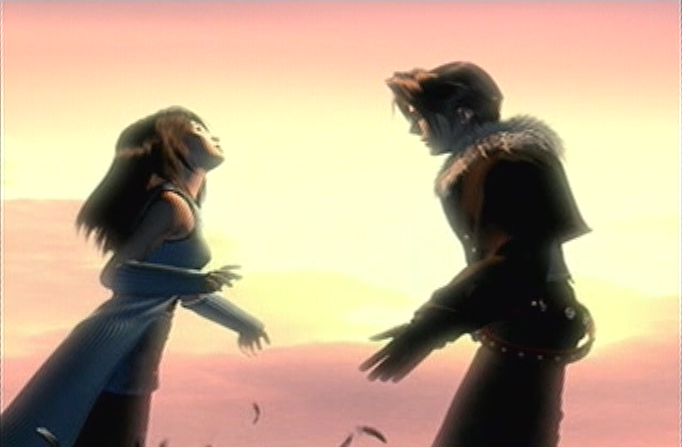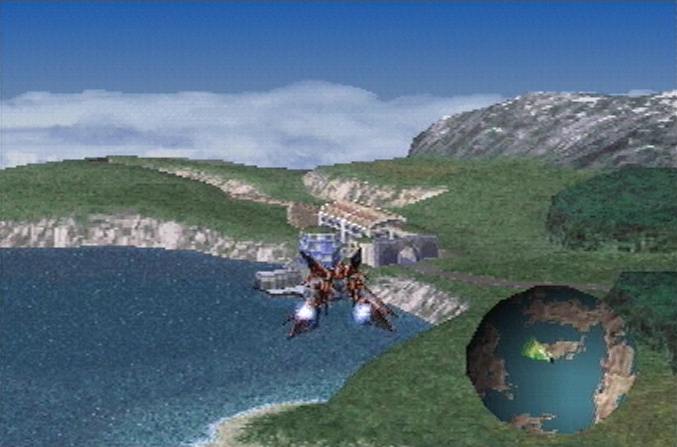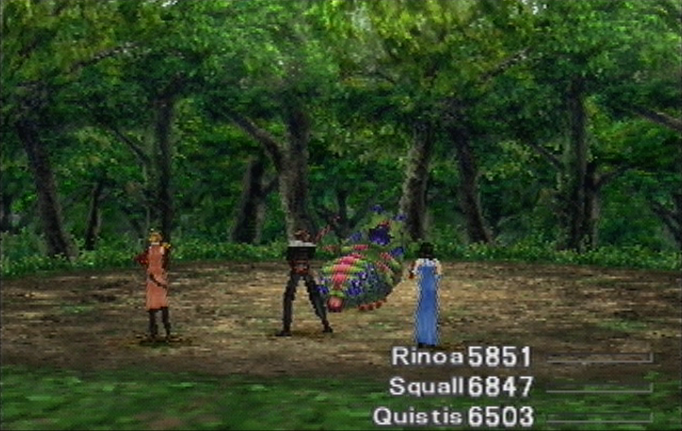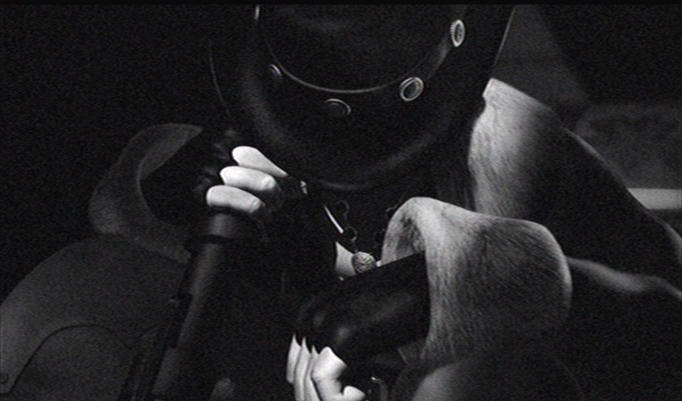FINAL FANTASY VIII (PS)
Final Fantasy fans would wait with bated breath until the eighth entry would arrive on PlayStation in 1999. After the mammoth success of FFVII would break barriers for Japanese localisation, Square would begin development of the next instalment during 1997 for a closer worldwide release. Despite becoming the fastest-selling Final Fantasy for the time, it split players down the middle: receiving acclaim from critics and fans at launch, yet becoming a target of criticism as the years would pass. Named as both the best and worst of the series depending on who you ask, some appreciating its unique traits, whilst others struggle to judge it without drawing comparisons to its colossal predecessors. But on its own terms, it’s a great JRPG.
Part of why long-term fans may turn their noses up at FFVIII is down to how much it tears up the rulebook as traits which came to define Final Fantasy have been abandoned. For starters, the world map is less Middle-Earth fantasy and more European sci-fi, as while previous games did incorporate more futuristic tech and motifs, this one commits fully to the aesthetic. Students of the Balamb Garden – including Squall – study to become members of a mercenary force SEED, with the Balamb Garden unravelling a labyrinth of technology. And while it is jarring at first, it gives the JRPG a distinct, well developed world which is enchanting to explore. Particularly once you acquire an airship, the world has tons of gorgeous locales to discover from the seaside-like Balamb Town to the desolate and haunting Great Salt Lake. It is arguably one of the best overworlds in the series’ history.
Part of why long-term fans may turn their noses up at FFVIII is down to how much it tears up the rulebook as traits which came to define Final Fantasy have been abandoned. For starters, the world map is less Middle-Earth fantasy and more European sci-fi, as while previous games did incorporate more futuristic tech and motifs, this one commits fully to the aesthetic. Students of the Balamb Garden – including Squall – study to become members of a mercenary force SEED, with the Balamb Garden unravelling a labyrinth of technology. And while it is jarring at first, it gives the JRPG a distinct, well developed world which is enchanting to explore. Particularly once you acquire an airship, the world has tons of gorgeous locales to discover from the seaside-like Balamb Town to the desolate and haunting Great Salt Lake. It is arguably one of the best overworlds in the series’ history.
It wouldn't be FF without sparkling seas, quirky architecture and deadly summon sequences
Square have always made tweaks to the turn-based formula but their eighth go-around would mark some dramatic shifts. Magic has seen the biggest overhaul as it is no longer a secondary element but a pivotal part of growing your party. Magic can be stolen from enemies, instead of being recharged by a meter, and via the Junction system, can then be assigned to a character’s stats to buff their stats. For example, junctioning an offensive magic such as Firaga will often improve attack stats, while healing magic will improve HP. This turns combat into not only a change to level-up your party, but also draw more potent magic in order to keep stats up.
In a way, it’s in-depth but also a touch on the convoluted side. You can reduce downtime by auto-assigning magic to stats to improve attack, magic or defence. But often, different monsters and bosses will favour magic types which forces constant tweaking. This can drag the pacing down a touch, as while the Materia system would often force long periods of scrolling in the menu, it feels like the convoluted Junction system leads to a lot of downtime. It also can clash with the traditional levelling system, as while levelling is somewhat important, it can cause imbalance as weak magic junctions often cause disastrous results despite improving your base level. Equally, there’s lots of little exploits to break the system entirely, swinging the game wildly between ease and difficulty.
In a way, it’s in-depth but also a touch on the convoluted side. You can reduce downtime by auto-assigning magic to stats to improve attack, magic or defence. But often, different monsters and bosses will favour magic types which forces constant tweaking. This can drag the pacing down a touch, as while the Materia system would often force long periods of scrolling in the menu, it feels like the convoluted Junction system leads to a lot of downtime. It also can clash with the traditional levelling system, as while levelling is somewhat important, it can cause imbalance as weak magic junctions often cause disastrous results despite improving your base level. Equally, there’s lots of little exploits to break the system entirely, swinging the game wildly between ease and difficulty.
Final Fantasy VIII delivers one of the most impressive world maps to feature in the series
But the flaws of the Junction can be overlooked when you uncover the sheer depth of this JRPG. Weapons can be upgraded by collecting magazines and then crafting them, entire side quests give fruitful rewards and Guardian Forces, this game’s version of summons, are worth hunting down. Then there’s Triple Triad, a seemingly throwaway card game that unveils incredible depth. Taking place on a 3X3 grid, your aim is to capture your opponents’ cards by placing higher-rank cards around opposing cards. With variable rules depending on who you challenge, hundreds of cards to collect and even combat rewards with resources earned from breaking down cards, Triple Triad is one of the most substantial mini-games in any title.
The only other sore points relate to the story. Squall’s brand of teenage angst can be relatable to some, but more often than not, he comes off as a whiny prick. Rinoa – the forced love interest of Squall – lacks any semblance of personality. The oddly structured love-story also feels cheap and tacked on. That’s not to say the whole cast is a misfire: Zell and Selphie make for a charming duo of bumbling goofs, Quistis is a charismatic tutor to the party and eventual addition Irvine makes for a somewhat out of place, yet likeable, gunslinger. There’s also a subplot involving reliving the memories of Laguna and his crew of soldiers, which arguably makes for better story than the core plot. But alas, it isn’t a huge part of the game.
The only other sore points relate to the story. Squall’s brand of teenage angst can be relatable to some, but more often than not, he comes off as a whiny prick. Rinoa – the forced love interest of Squall – lacks any semblance of personality. The oddly structured love-story also feels cheap and tacked on. That’s not to say the whole cast is a misfire: Zell and Selphie make for a charming duo of bumbling goofs, Quistis is a charismatic tutor to the party and eventual addition Irvine makes for a somewhat out of place, yet likeable, gunslinger. There’s also a subplot involving reliving the memories of Laguna and his crew of soldiers, which arguably makes for better story than the core plot. But alas, it isn’t a huge part of the game.
One element Square rarely faltered on with its JRPGs is the graphics, and Final Fantasy VIII may be the best looking PlayStation game out there. Unlike FFVII’s more deformed characters, characters benefit from a far more human-like appearance with individual fingers, trinkets of clothing and improved animations. The gorgeous FMV sequences return too, actually sometimes combining both gameplay characters with the full-motion video for a stunning look. The pre-rendered backgrounds are gorgeous, as the fixed perspective captures the beauty of each screen perfectly. Battles look great too, with stunning monster designs and screen-filling Guardian Force summons that push the PS to the limit. The sound is good too, as while there aren’t a great deal of memorable tracks contained within FFVIII, many do manage to fit the tone and setting very well along with more traditional sound effects.
In the end, Final Fantasy VIII lives up to the legacy of the franchise despite some missteps. It’s true that the Junction system is far from flawless, and the roster of characters can vary from bland to downright unlikeable. But with cutting edge graphics, an outstanding world to explore and close to hundreds of hours worth of content, Square’s penchant for creating deep, absorbing JRPGs was in full force here. Fans of the series and genre alike would do well to revisit this one, as while perhaps not as good as FFs IV, VI or VII in the grand scheme of things: it’s a damn good JRPG.
In the end, Final Fantasy VIII lives up to the legacy of the franchise despite some missteps. It’s true that the Junction system is far from flawless, and the roster of characters can vary from bland to downright unlikeable. But with cutting edge graphics, an outstanding world to explore and close to hundreds of hours worth of content, Square’s penchant for creating deep, absorbing JRPGs was in full force here. Fans of the series and genre alike would do well to revisit this one, as while perhaps not as good as FFs IV, VI or VII in the grand scheme of things: it’s a damn good JRPG.
|
|
VERDICT
Visual: 10/10
Audio: 8/10 Gameplay: 8/10 Longevity: 10/10 OVERALL: 8/10 |
